The Spiny World of Opuntia
While traveling in California last month with the American Public Garden Association Annual Conference, we had the opportunity to visit Joshua Tree National Park and experience some unique desert flora and fauna. One of our favorite stops was the Cholla Cactus Garden.
This garden is a stand of Opuntia bigelovii, also known as the teddy-bear cholla. There is nothing cuddly about this cactus as you can see from the image. The desert sun really highlighted the bright yellow spines. A native of Nevada and Arizona, another common name for this Opuntia is jumping cholla because the spines seem to attach to a passerby if looked at the wrong way. As a desert plant, it can withstand an air temperature of 138o F.
While we cannot grow this attractive Opuntia in the Delaware Valley, the Arboretum has been trialing several other cultivars of Opuntias throughout the grounds. Our curator, Andrew Bunting, began experimenting with Opuntias after successfully growing the native Opuntia humifusa, prickly pear, in the John W. Nason Garden. In the Nason Garden, O. humifusa adds great texture with its large pads and unique spines. Prickly pear also produces striking, broadly funnel-shaped bright yellow flowers in late spring/early summer.
Another successful collection of Opuntias can found in our hardy containers outside Pearson hall. The most attractive (in my opinion) is Opuntia violacea, purple prickly pear. True to its name, this Opuntia has bluish-purple stems and blooms with yellow, cup-shaped flowers in the late spring/early summer. In container P7 at Pearson Hall, the specimen has a lovely trailing habit down the side of the planter.
The Arboretum’s greatest concentration of Opuntia can be found outside the Science Center, next to the large glass windows of Eldrigde Commons. This corner of the building is dry and hot because of a building overhang and its location at the corner of the Science Center. It seemed a perfect spot for a cactus collection.
Among the various types of Opuntia to be seen in this garden, the upright form of Opuntia imbricata (magenta flowered form) stands out. This Opuntia, also known as the chain-link cactus, produces funnel-shaped magenta flowers in the late spring/early summer.
Explore the diverse world of Opuntia at the Scott Arboretum to see which one of our spiny friends you would like to add to your garden. Be sure to stop by late next spring to experience the diversity of flower colors and forms produced by these unique garden plants.





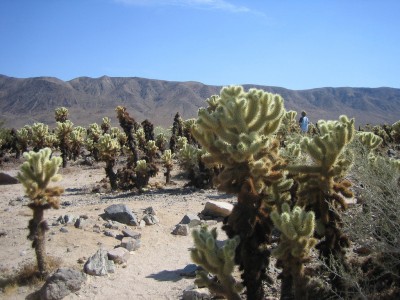
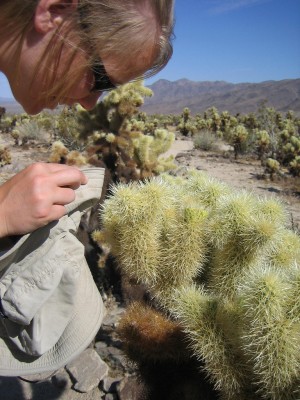
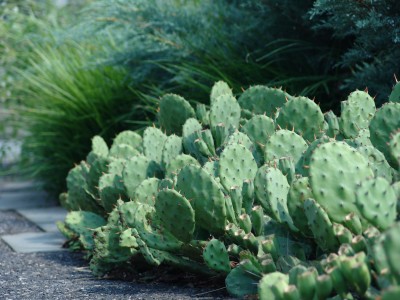
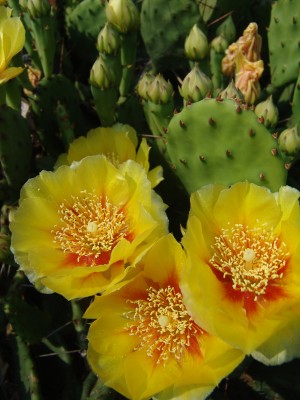
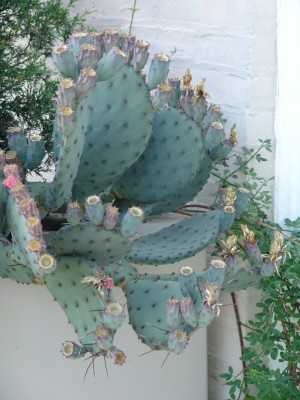
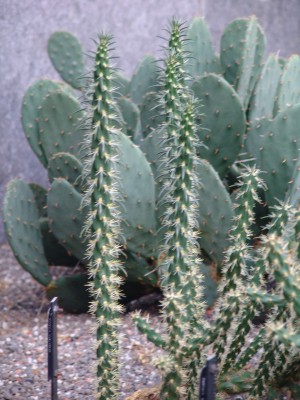
Wolf
Posted at 08:17h, 29 JuneI have not been in California but I have been 20 years ago in Marocco. There I took a Opuntia and this plant is in my house since this time. I have written about it here: http://garten-anders.blogspot.com/2009/06/opuntia-als-mitbringsel-vermehrung.html. Unfortenately it is in German but you may look at the fotos. There is only one thing Opuntia do not like: To much water.
Wolf
Ian
Posted at 19:57h, 26 OctoberI am interested in obtaining seed of bigelovii. Although they rarely produce seed, I am sure that they must produce some. No doubt the awesome defense puts people off looking for viable fruits! It may be the case that any viable seed will be hybrid, especially if fulgida or other Cylindropuntia occur nearby. I would also like to hear from anyone who has successfully germinated this plant from seed, or found seedlings in the wild state.
Ian
Joe Shaw
Posted at 17:00h, 26 NovemberHi,
Nice job on the post about Opuntia. This is a (mostly) neglected group of plants that have fascinating biology and which can be beautiful in gardens.
Joe
http://www.opuntiads.com